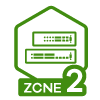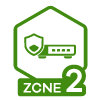Can someone explain to me how you get 22Gbps across a 10GbE ethernet connection?
The new WiFi 7 access point, is claiming 22Gbps speeds, but only has a single 10GbE uplink. How do you get 22Gbps across a 10GbE ethernet connection?
https://store.zyxel.com/wbe660s-us0101f.html
Accepted Solution
-
Hi there,
Thank you for your interest in our Wi-Fi 7 AP (BE22000).
The 22Gbps speed for the new Wi-Fi 7 access point is a theoretical maximum that combines the potential speeds of all wireless bands (2.4GHz: 1376 Mbps, 5GHz: 8646 Mbps, and 6GHz: 11530 Mbps) under ideal conditions.
In the reality, wireless throughput – the actual data speed that can be achieved – is typically lower than the transmission rate due to overhead such as encryption, packet headers, and environmental factors that cause interference. In optimal conditions, the practical maximum speed may achieve 60-70% capacity per band. It's important to note that actual throughput may vary based on the number of clients, network environment, and other influencing factors.
Therefore, the 10GbE as the uplink speed is more than sufficient for the aggregate data rates that will realistically be achieved by the access point in typical usage scenarios.
Zyxel_Judy
0
All Replies
-
Iirc, wireless frame header encryption etc is minimal. I was surprised Zyxel did not use link aggregation like some of their competitors with a second 10Gbps RJ45 or even SFP+ with 40Gbps. The high POE 40 watts level is also interesting. The full power mode would be supported by a XS-1930-12HP (60 watts), but you might want higher gauge CAT-6A ca or CAT 8. This would overpower the new USG Flex 500H or 700H with only 30 watts thus need the reduced functionality setting. Hopefully this would at least help users at the edge of the AP range. I definitely like that it is all 4x4 for all frequencies. Wonder when it will be supported by the AP management in the USG Flex series. The WAX 6E APs are still not there yet.
0 -
That 22Gbps number is not quite advertising fiction, but … what it is is the maximum possible TX rate for all bands added together. It is never possible for actual WiFi throughput to get anywhere near the channel's TX rate. Usually, if you get two-thirds of that on a sustained basis, you should figure you're doing well. On top of that, you need a client for each band that is capable of using the max TX rate —- that is, it has as many MIMO channels as the AP and can use the maximum rated channel width. And you need all of those clients going flat-out simultaneously. And you need no interference from anybody else, which for either the 2.4GHz or 5GHz bands means you're living in the boonies (where you can't get 10Gbps internet service in the first place). So I imagine that a 10Gbps uplink is plenty in practice. I wonder whether the AP even has enough CPU power and switching fabric to saturate that uplink. The advertising number doesn't speak to that at all.
0 -
Hi there,
Thank you for your interest in our Wi-Fi 7 AP (BE22000).
The 22Gbps speed for the new Wi-Fi 7 access point is a theoretical maximum that combines the potential speeds of all wireless bands (2.4GHz: 1376 Mbps, 5GHz: 8646 Mbps, and 6GHz: 11530 Mbps) under ideal conditions.
In the reality, wireless throughput – the actual data speed that can be achieved – is typically lower than the transmission rate due to overhead such as encryption, packet headers, and environmental factors that cause interference. In optimal conditions, the practical maximum speed may achieve 60-70% capacity per band. It's important to note that actual throughput may vary based on the number of clients, network environment, and other influencing factors.
Therefore, the 10GbE as the uplink speed is more than sufficient for the aggregate data rates that will realistically be achieved by the access point in typical usage scenarios.
Zyxel_Judy
0
Categories
- All Categories
- 441 Beta Program
- 2.9K Nebula
- 209 Nebula Ideas
- 127 Nebula Status and Incidents
- 6.4K Security
- 534 USG FLEX H Series
- 338 Security Ideas
- 1.7K Switch
- 84 Switch Ideas
- 1.3K Wireless
- 51 Wireless Ideas
- 6.9K Consumer Product
- 295 Service & License
- 461 News and Release
- 90 Security Advisories
- 31 Education Center
- 10 [Campaign] Zyxel Network Detective
- 4.7K FAQ
- 34 Documents
- 86 About Community
- 99 Security Highlight
 Freshman Member
Freshman Member
 Zyxel Employee
Zyxel Employee




 Ally Member
Ally Member




